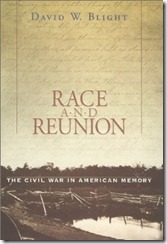A month and 146 years ago as of June 1, according to documents discovered a decade or so ago in a Harvard archive, the first seedling for what we just observed as Memorial Day sprouted just less than a week after the surrender in Durham, NC that effectively ended the Civil War, and not several years later as previously thought.
Fittingly, this earliest precursor occurred in Charleston, SC during the final year of the conflict also known as the War Between The States that began there 150 years ago this past April. A year ago, Long-time Mayor Joseph P. Riley of that community dedicated a marker to commemorate the newly revealed memorial event.
It gives one goose-bumps to think of 10,000 former slaves and black Union troops marching silently, preceded by nearly 3,000 black children softly singing the anthem “John Brown’s Body”.
Reading the op-ed in yesterday’s New York Times, as I hope everyone did or will, by David W. Blight, the Yale history professor who uncovered the story reminded me of his 2001 book, Race and Reunion where I believe I first read the account.
For some reason, the op-ed has also taken my thoughts this week back to the War of 1812 that ended the life of John Neeley.
He was one of only 2,260 American soldiers killed in action during that two-and-one-half year war, which was declared 199 years ago today, just 20 days shy of 24 years after ratification of The Constitution of the United States of America.
The year the American Revolutionary War ended, Neeley was born in the Village of Ovid, between the western New York finger lakes of Seneca and Cayuga, and he is the great (times six) grandfather of my two grandsons.
The War of 1812 is often overlooked, but in proportion to today’s population numbers, the American lives lost would tally 91,000 which is nearly 20 times the number killed in action as of last Sunday’s report during the on-going wars in Iraq and Afghanistan combined which have already spanned four times a long.
Lewis Neeley, a likely abolitionist, was just a six-year old when his father John Neeley was killed in action; and 14 or 15 years before the outbreak of the Civil War he departed New York with his wife and children to ultimately settle in the Far West.
After losing his wife to illness on the bluffs of western Iowa as they overlook the Missouri River into Nebraska he caught a wagon train 161 years ago this month, along with his son Armenius who was one of my paternal great-great grandfathers, and traveled across the plains, then up and over the Great Divide to what Wallace Stegner later termed the Geography of Hope.
1 comment:
Very interesting. Thanks for flagging the David Blight op-ed, as I had not yet seen it. I am currently listening (through iTunes U) to Blight's Yale course on the Civil War. It's fascinating and a wonderful listen if you have not yet encountered it: http://bit.ly/i4xlmO
Post a Comment